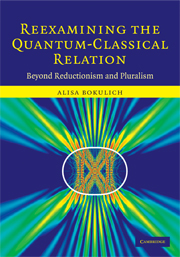Book contents
- Frontmatter
- Contents
- Acknowledgements
- Introduction
- 1 Intertheoretic relations: Are imperialism and isolationism our only options?
- 2 Heisenberg's closed theories and pluralistic realism
- 3 Dirac's open theories and the reciprocal correspondence principle
- 4 Bohr's generalization of classical mechanics
- 5 Semiclassical mechanics: Putting quantum flesh on classical bones
- 6 Can classical structures explain quantum phenomena?
- 7 A structural approach to intertheoretic relations
- References
- Index
6 - Can classical structures explain quantum phenomena?
Published online by Cambridge University Press: 04 August 2010
- Frontmatter
- Contents
- Acknowledgements
- Introduction
- 1 Intertheoretic relations: Are imperialism and isolationism our only options?
- 2 Heisenberg's closed theories and pluralistic realism
- 3 Dirac's open theories and the reciprocal correspondence principle
- 4 Bohr's generalization of classical mechanics
- 5 Semiclassical mechanics: Putting quantum flesh on classical bones
- 6 Can classical structures explain quantum phenomena?
- 7 A structural approach to intertheoretic relations
- References
- Index
Summary
… there is something in this more than natural, if philosophy could find it out.
Shakespeare, Hamlet, Act 2 Scene 2Introduction
The philosophical importance of semiclassical appeals to classical structures in explaining quantum phenomena was first recognized by Robert Batterman (1993; 1995; 2002). More generally, Batterman has argued that when it comes to explaining phenomena in the asymptotic domain between two theories, the fundamental theory describing that domain is often explanatorily deficient, and an adequate explanation must make essential reference to the less fundamental theory. For example, in discussing the relation between classical and quantum mechanics, Batterman writes, “There are many aspects of the semiclassical limit of quantum mechanics that cannot be explained purely in quantum mechanical terms, though they are in some sense quantum mechanical … [T]hese quantum mechanical features require reference to classical properties for their full explanation” (Batterman 2002, pp. 109–10). He has extended these arguments to other theory pairs with singular limits as well, arguing that in optics, for example, one finds explanations of wave-theoretic phenomena that make an essential and ineliminable appeal to ray-theoretic structures such as caustics.
More recently, Batterman's arguments have been the subject of considerable criticism from figures such as Clifford Hooker (2004), Michael Redhead (2004), and Gordon Belot (2005). These criticisms have tended to cluster around the following two assumptions: First, in saying that a classical structure (such as a trajectory or caustic) explains, one is thereby committed to the claim that the structure exists.
- Type
- Chapter
- Information
- Reexamining the Quantum-Classical RelationBeyond Reductionism and Pluralism, pp. 135 - 155Publisher: Cambridge University PressPrint publication year: 2008



